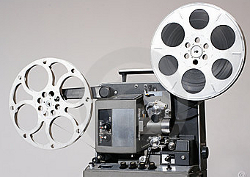|
Museum in need of an old-fashioned
projector |
|
February 5, 2012 |
 |
|
What a 16mm
projector might look like. |
The Boundary County Museum and Historical
Society is willing to do whatever it takes to
get their hands on a working 16-millimeter film
projector.
If anyone knows where one might be acquired,
they are willing to beg, borrow, buy or steal!
The museum has acquired three reels of old
county logging operations that no one has
recently seen, because they don't have a 16mm
film projector, a device once as common as the
manual typewriter and the mimeograph machine.
Once upon a time, in days of old (probably up
until about the year 2000), these antiques were
used to project a series of images captured by a
"video camera," a device that clicked and
clacked and took a series of "photographs" and
saved them on a cellulite film which the
projector could then project upon a flat, white
screen, called a "screen," often operated in
local schools by trusted students in upper
grades.
Instead of discs, dvd-rws or thumb drives, this
film was stored on "reels."
While many of the reels the images were stored
on were of interest, such as "The Life Cycle of
the Common Garden Spider" and "Gone With the
Wind," the most excitement at these movies,
uploaded onto a complex series of cogs,
sprockets and wheels onto the projector, came
when the film got stuck in the machine, and the
exceedingly hot light bulb behind the "film" now
locked onto a "cell," melted the image into a
kaliedoscope of colors on the "screen." Often,
this was the best part of the movie, and it may
have presaged and inspired the psychedelic era
of the '60s.
Another great thing about the 16mm projector was
that at the end of the "movie," a term coined
because the projected image seemed to move, came
when the tail end of the film ran out and the
gears, sprockets and wheels of the projector
sped up due to decreased drag, and the "fap,
fap, fap!" of the film spinning on the take-up
reel woke everyone who'd fallen asleep in class
before the teacher could turn up the lights.
It was a truly marvelous machine.
While few today are aware of it, the analog
media stored on 16mm film could be stretched
between fingers and held up to any light,
revealing "stills," or single images, in a
series of photographs that, when projected
through the 16mm projector at precisely the
right speed, gave the illusion of motion ... an
amazing advent developed in the late 1800s by a
man named Thomas Alva Edison, who also invented
the "light bulb."
His invention bought still images to life.
And that's why the folks at the Museum want to
acquire, by nefarious means or fair, a 16mm
projector ... the stills they see are
interesting, and ready to be brought to life ...
they provide a rare glimpse into part of our
county's past recorded on the most advanced
media of the day.
It's the hope of museum officials that if they
can obtain the equipment to properly display the
media, they can then record and save it to all
the more modern media ... microfiche, 5 1/4-inch
floppy disc, hard-shelled 3-1/4 discs, COBAL,
DOS, the Inernet, CD-ROM, DVD.
If you have or know of a working16mm film
projector available for purchase or theft, call
(208) 267-7720 or email
bcmuseum@meadowcreek.com.
You might also be able to reach them by
telegraph, walkie-talkie or rotary-dial
"telephone," or even etched on "paper" with such
out-dated implements as "pencil," "pen" or
"typewriter" (an archaic and noisy device that
students once slaved over that didn't feature
automatic return, auto-correct or spell check)
... but it's doubtful.
While they have much of the equipment on
display, not much of it is hooked up to the
telegraph, and most of it is not Interweb
compatible.
And they don't have a 16mm film projector. |
|
|
|
|

